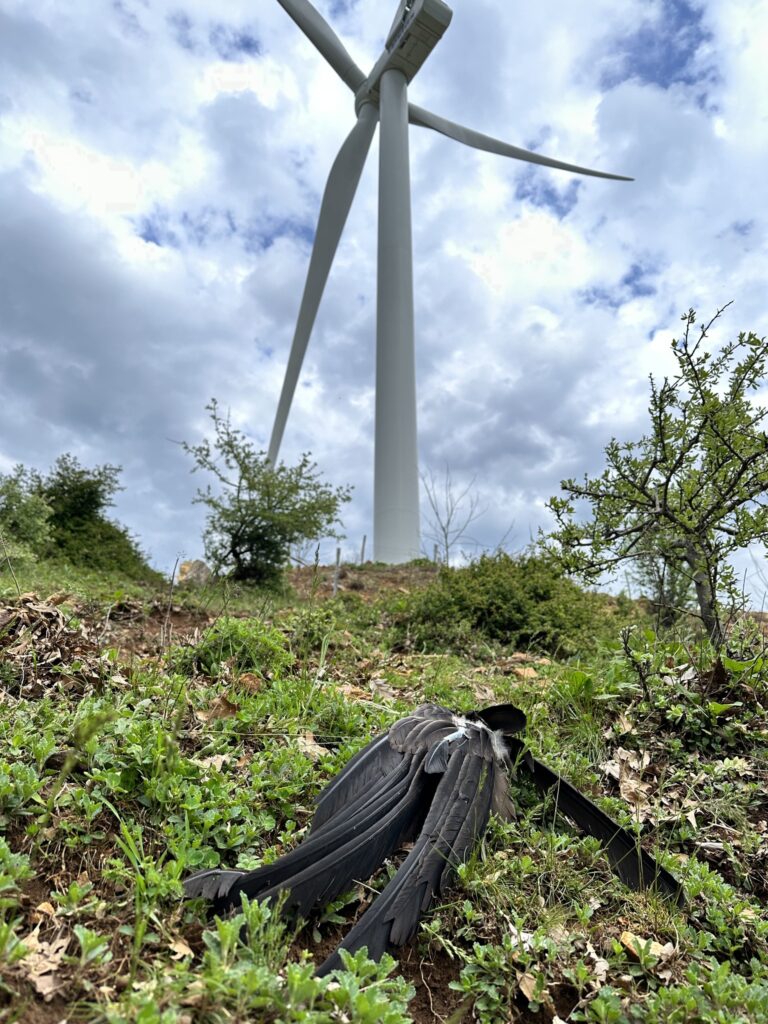In a tragic incident on 30 April, a Cinereous Vulture collided with a wind turbine in the “Filiouri Valley” Important Bird Area in Thrace, Greece. This unfortunate event has once again shed light on the increasing cumulative effects of wind turbines on protected birds of prey and vultures in the region. The incident serves as a stark reminder of the urgent need to address the proper increasing development of wind turbines in important vulture areas to protect these vital species.


Another Cinereous Vulture victim in Thrace-Greece
On 30 April, a Cinereous Vulture (Aegypius monachus) flying in the mountainous region of the Rhodope Mountains in Greece collided with a wind turbine in the “Filiouri Valley” Important Bird Area. Thanks to a satellite transmitter, the vulture was located, prompting the Society for the Protection of Biodiversity of Thrace (SPBT) to take immediate action. With the assistance of the Management Unit of Evros Delta and Dadia National Parks and the Forestry Service, the injured vulture was transported to the Hellenic Wildlife Care Association – ANIMA. Sadly, the vulture will never fly again due to the amputation of part of its wing.
This vulture was part of the new Cinereous Vulture reintroduction project in the Bulgarian part of the Eastern Rhodopes, led by the Bulgarian Society for the Protection of Birds (BSPB). This 3-year-old female was released in November 2022 alongside 13 other Spanish Cinereous Vultures in the region, where it has been extinct as a breeding species since 1993. Ahead of the release, they tagged her with satellite transmitters, which recorded her location every 10 minutes and allowed her swift detection.
Cumulative effects of wind turbines
This recent incident is not an isolated event but highlights a concerning trend. As wind turbines continue to increase in the mountains of Evros and Rhodope, the cumulative effects on protected birds of prey and vultures intensify. In Thrace alone, this Cinereous Vulture becomes the sixth victim of a wind turbine collision, bringing the total number of recorded incidents with birds of prey and vultures to 27. However, it is important to note that the actual number of victims is likely much higher, as many go undetected.
Impact on Important Bird Areas
The “Filiouri Valley” in Rhodope is an Important Bird Area frequently used by vultures for foraging due to the presence of extensive livestock farming. Unfortunately, the accumulation of wind turbines in the area has significantly degraded this vital habitat. Of the 265 wind turbines installed in the Evros and Rhodope regions, the majority are concentrated in the “Filiouri Valley.”
Wind farms and avian mortality
The collision between wind turbines and birds is a widespread concern, not limited to Greece. During the first systematic survey of dead birds at established wind farms in the region between 2008-2010, WWF Greece detected four Griffon Vultures, one Cinereous Vulture, two Short-toed snake eagle, one Booted eagle, three kestrels, two Eurasian sparrowhawks, one Western marsh harrier, 84 other birds and 194 bats. In Spain alone, where approximately 90-95% of the entire European vulture population is present, nearly 10,000 vultures died due to wind turbine collisions according to data collected over the past 20 years.
Balancing renewable energy and biodiversity conservation
While wind farms can play an important role in mitigating climate change and reducing reliance on fossil fuels, they must be developed with careful consideration for biodiversity. Poorly planned wind farm developments pose a significant threat to vultures, birds, and bats, particularly if they are situated near breeding colonies, roosts, or migratory pathways. In Thrace, the installation of wind turbines within Natura 2000 sites and Important Bird Areas further exacerbates the risks. To prevent such accidents, the cumulative impact of existing and planned wind farms must be evaluated, and exclusion zones should be established. Urgent action is needed to address the siting of wind turbines and safeguard the vultures and raptor species that rely on these areas.
The VCF and partners have been engaging with a number of researchers and also with energy operators to provide data about the occurrence of vulture species, to try to prevent the establishment of wind farms in important corridors or breeding areas. The organisation is also involved in multiple projects funded by the EU’s LIFE Programme and MAVA Foundation that work to minimize the threat of collision to vultures.
Source: SPBT







